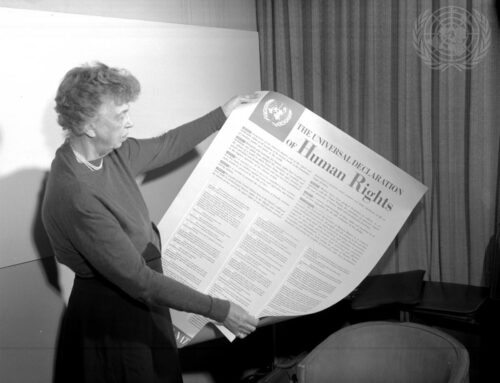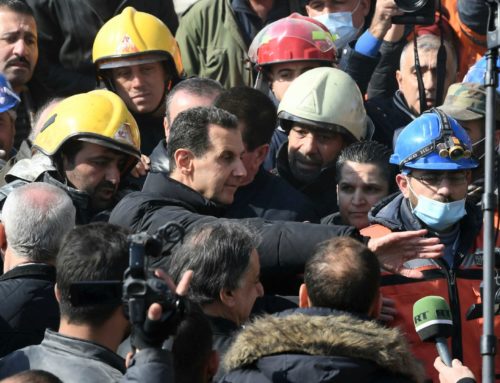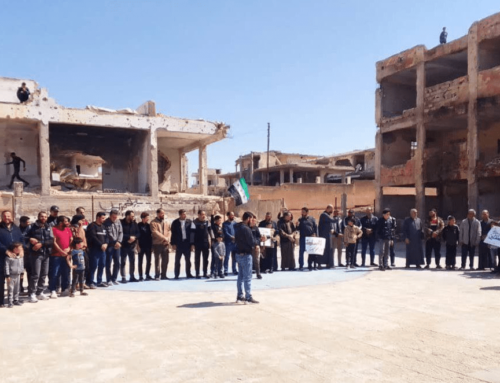Op-Ed: UN cross-border aid hangs in the balance as politics and need collide
On July 10, the UN Security Council will decide whether to renew a cross-border aid resolution that millions of people in northwestern Syria rely on. "A catastrophe is possible, and we must prepare for it," writes Mohamad Katoub.
29 June 2022
On July 10, the United Nations Security Council will vote on renewing a resolution authorizing cross-border humanitarian aid to Syria. Failure to renew it could lead to a real disaster, according to the picture painted by parties supporting renewal, be they UN agencies, humanitarian NGOs or even diplomatic missions concerned with the Syrian issue. Is it true that there are no alternative solutions if the resolution is not renewed? Or does nobody want alternative solutions?
Non-renewal is a fait accompli
When talking about the renewal of Security Council Resolution 2585 of 2021, there are several points. First, and most importantly, is that non-renewal has been a reality for more than two years. In northeastern Syria, more than two million Syrians are suffering after UN agencies stopped bringing in aid through the al-Yarubiya border crossing with Iraqi Kurdistan immediately after Resolution 2533 of July 2020 was issued. Under the resolution, work through the al-Yarubiya crossing was canceled, and aid access was limited to one border crossing, Bab al-Hawa, which serves residents of northwestern Syria. Since then, humanitarian organizations in eastern Syria have used the Simalka crossing with Iraqi Kurdistan to bring in aid, and no UN aid enters through it.
The above leads us to a second point, which is that the assurances from donor countries—especially Security Council member states—that the resolution will be renewed in July may not be true. It is not possible to establish that the resolution will be renewed on the basis of these assurances.
The “lifeline,” as United States Ambassador to the UN Linda Thomas-Greenfield has repeatedly described it, is already cut in Syria’s northeast, an area that is supposedly a priority for the US government. While diplomatic statements in favor of renewing the cross-border aid resolution last year included the need to reactivate the al-Yarubiya crossing, this year’s statements are content to stress the need to increase humanitarian crossings, without specifying the area.
A catastrophe is possible, and we must prepare for it.
It must be pointed out that a cross-border response with the presence of UN agencies is the best form of humanitarian response in areas outside regime control. The response to these areas cannot pass through Damascus, since the Syrian regime has a long history of obstructing humanitarian assistance. The withdrawal of UN agencies would create a gap that cannot be compensated for, not to mention that the presence of UN agencies makes it very convenient for donors to allocate large sums. It also protects local organizations in host countries, especially with increasing Turkish pressure on the work of humanitarian organizations.
This form of response is currently taking place through a Security Council resolution. So what are the prospects for maintaining the same mechanism without a resolution, and without the strenuous efforts to pressure Russia to renew it, every year?
How much does it cost to negotiate with the Russians? Does it cost more than finding alternative solutions, after seven years of renewals?
Cross-border aid, or cross-border politics
This year, Thomas-Greenfield and a number of Western diplomats are repeating the same calls as in 2021 to renew the resolution, with similar scenes and similar meetings with the same actor. The US ambassador to the UN visited border areas with Syria and held a series of meetings in Turkey this month.
From the Turkish side, there is great interest in renewing the cross-border aid resolution. Its importance increases in the event Turkey is able to carry out its plan, announced by President Recep Erdoğan in May, to return one million refugees to Syria. The “voluntary return” plan could mean a further deterioration of the humanitarian situation in an area where approximately 1.7 million people live in displacement camps. It would exacerbate the problem of providing shelter and services in northwestern Syria, especially in light of a significant decline in funding for humanitarian response. The health and education sectors are suffering from a severe funding shortage that could lead to the closure of dozens of hospitals and hundreds of schools.
Read More: Women in northwestern Syria pay the price of donor fatigue
Turkey, more than other countries, needs all channels to maintain the continued access of aid to northwestern Syria. While it previously had reservations that played a part in stopping the continuation of the same aid channels to Syrian Democratic Forces (SDF)-controlled northeastern Syria, it is the country with the longest border with Syria, and six million people live on the other side of that border.
It appears clear that the crossings still in operation are those that Turkey wants to continue, while those it has reservations about have closed.
Last year, like every year, the cross-border issue was used politically to the furthest extent. US President Joe Biden brought up the issue in a meeting with Russian President Vladimir Putin in Geneva before the renewal vote. According to former US ambassador to Syria Robert Ford, Biden was not sufficiently prepared to discuss Syria in the meeting, while Putin came with his Syria advisers. This indicates the Russians are serious about dealing with the issue, while the American side uses it more as a media tool.
The dynamics are different this year, in light of the Russia-Ukraine war. No matter how much US officials say they are trying to separate the two crises, the main actors are the Russians themselves. And the Turkish government is not at all absent from the scene in both crises. [Ed.: Turkey is a member of NATO, has sold locally produced drones to Ukraine, and closed the strategically important straits connecting the Mediterranean and Aegean Seas to the Black Sea to all warships following Russia’s invasion of Ukraine in February. Ankara also navigates complex relations with Russia in northwestern Syria, as a ceasefire guarantor and as a backer of Syrian forces opposed to the Moscow-backed Assad government.]
Across the Security Council, or across the border?
In practice, halting the cross-border aid resolution stops UN agencies’ authority to operate across the border, not the delivery of aid. Aid crossed the border before the initial 2014 Security Council resolution.
It is not actually in the interest of any of the Security Council members—including Russia—to not renew the resolution. The cross-border mechanism is a bargaining chip the Russians use every year to make gains. Eliminating it would mean they have done away with the goose that lays a golden egg every year. Russia continues to push for sanctions to be lifted from Syria, and there is some talk in UN corridors about the possibility of passing the resolution in exchange for some sanctions flexibility.
As for the remaining members of the Security Council, they will not set a precedent for cross-border UN assistance into a non-international conflict without Security Council approval. UN agencies could use such a precedent in other countries, which some members may not want.
Cross-border humanitarian operations began from the first days of opposition control of border crossings with neighboring countries in 2012, facilitated by those countries themselves. This was done with support from Syrian expatriates, civil associations abroad, and Arab and international organizations in different forms. None of those parties waited for the UN agencies.
As need grew, forums and alliances of these organizations began to form in countries neighboring Syria to coordinate their work. Then, the international humanitarian platforms began to form. For example, in 2013 and 2014, the cross-border response was coordinated by a forum of NGOs in northwestern Syria, and the UN Office for the Coordination of Humanitarian Affairs (OCHA) had already started working in Gaziantep, southern Turkey before any of these resolutions were issued.
After that, it became urgent for the UN to intervene operationally, especially with the Syrian regime placing major obstacles in the way of humanitarian aid access to areas outside of its control. Security Council Resolution 2139 was issued in February 2014, allowing for cross-border UN operations and calling on all parties to facilitate these operations.
Resolution 2139 did not contain a timeframe or geographical sphere for implementation. Under this resolution, cross-border entry of aid was allowed through all border crossings, without a validity period requiring renewal. The first cross-border UN convoy entered Syria through Jordan’s Ramtha border crossing in April 2014, before Resolution 2165 was issued in July 2014 providing for humanitarian aid to enter Syria through four border points: Bab al-Salam and Bab al-Hawa from Turkey, Ramtha from Jordan and al-Yarubiya from Iraq.
Over five months, Russia worked to restrict Resolution 2139, and it was re-implemented under the dome of the Security Council through Resolution 2165 to be within a geographical framework limited exclusively to four border crossings, and within a timeframe renewed every six months or one year, under a monitoring mechanism led by the UN Secretary-General. All subsequent versions of the cross-border aid mechanism renew Resolution 2165, not 2139.
In effect, Resolution 2165 restored Security Council control over the humanitarian operation after it launched it with Resolution 2139. Certainly, this was not in the interest of any of the groups working in the humanitarian field, including UN agencies. But it was in the interest of all the member states of the Security Council wishing to maintain authority over the resolution and its political use.
Subsequent versions of Resolution 2165 continued to pull back the authority of cross-border operations in favor of returning control over the humanitarian operation to Damascus. The resolution’s wording changed, and access was narrowed geographically, until Resolution 2533 in July 2020 limited cross-border entry to only the Bab al-Hawa crossing. With that, UN humanitarian aid no longer entered northeastern Syria or Daraa province in the country’s south.
In July 2021, the latest version, Resolution 2585, carried not only a decline in cross-border operations, but also a change in the language and conditions of the resolution. The resolution linked the provision of cross-border aid to cross-line operations from Damascus across contact lines with opposition areas.
The 2021 version of the resolution encouraged early recovery assistance through the International Committee of the Red Cross (ICRC), which operates from Damascus without any cross-border operations.
Since July 2021, at least five convoys have entered opposition areas in northwestern Syria from Damascus, which never happened in the preceding years. The World Food Program (WFP), the main contributor to these convoys, carried them out without prior planning with any organization to implement the aid in Idlib. The convoys entered to prove that aid implementation is possible through Damascus alone.
While the entry of aid from Damascus was met with refusal by northwestern Syrian organizations—which have been cooperating with UN agencies within programming partnerships for years—the local authorities affiliated with Hayat Tahrir al-Sham (HTS) have not prevented aid from entering.
According to what is happening in the halls of UN humanitarian chambers, it appears that UN agencies could resort to contracting with private sector companies to implement cross-line aid from Damascus in the event that humanitarian organizations refuse to deal with the Damascus offices. This would weaken transparency surrounding the future plans of UN agencies regarding cross-border implementation, and likely also result in conflicting information between one agency and another.
UN Surprises
This month, information was leaked about a regional meeting between UN agencies, in which they were informed that the UN Office of Legal Affairs considers that, if the Security Council does not renew the resolution, it will immediately suspend all operations. This includes contracts and funding, even those that do not expire on July 10, 2022.
For the agencies, this is the safe path, which will lead them to the least possible pressure from international parties, led by the Syrian government. It will also maintain the agencies’ relationships with Damascus, which they deem a greater priority than reaching the populations in need. But this move would mean a sudden cutting of aid without alternatives or emergency plans to replace it.
An independent legal analysis commissioned by OCHA and the University of Oxford a few years ago addressed an important aspect of cross-border humanitarian operations: the legal dimension. The analysis went on to say it is not possible to work across borders in non-international conflicts without Security Council approval, as in the case of Syria. The passage of international aid across borders without the consent of the country in question is considered a violation of national sovereignty, while there are other considerations in international conflicts.
The paper clearly describes that, in a similar case, the International Court of Justice (ICJ) refused a complaint brought about a cross-border response in Nicaragua without Security Council approval. Of course, it would be easy for countries such as Turkey, the US or even Israel to pass cross-border aid into Syria. The three countries carry out military operations in Syrian airspace and territory, and the legal dimension would not stop them from carrying out humanitarian operations if they desired to. But UN agencies can only follow international law.
The independent analysis proposed three possible forms of cross-border action, through which the problem of state consent and Security Council approval can be bypassed:
- Indirect provision of aid or funds, without the involvement of international staff in implementation, and without a physical presence in the territory of the country in which the response is taking place.
- Coordination and supporting funding requests.
- Collecting information about needs for advocacy purposes.
For years, with every renewal of the cross-border aid mechanism, UN agencies have repeatedly assured their partners that their plan in pressing for it to be renewed is that there is no alternative, and therefore the Security Council has no choice but to renew. They say it most likely will be renewed, and that they continue to support Syrian partners across the border even if it is not. And they say that in the worst case scenario, they will work through a transitional phase in which cross-border operations move from the hands of the UN to international and Syrian partner organizations.
The lesson learned from the closure of the al-Yarubiya crossing in northeastern Syria is that these assurances are not real. Since July 2020, there has been no UN aid to the area, as agencies withdrew immediately after the crossing was excluded from that year’s resolution. There was no transitional period, and to this day donors are still developing alternative channels for the response there, with a clear failure in cross-line implementation and COVID-19 response through the UN offices in Qamishli. This is to say nothing of dozens of examples in besieged areas for years.
Taking into account the high level of bureaucracy governing the humanitarian operation, international donors—mainly European Union countries, the US and the United Kingdom—will need several years to develop alternative channels to the UN agencies to deliver aid. This gap can be clearly seen in the northeast.
Going back to the pre-2014 model, when the response relied on local organizations and donations from the Syrian diaspora, is inapplicable—not to mention useless—now. At the time, the Turkish government showed great flexibility with all those wishing to work across the border, but this flexibility has completely disappeared. The scale of the need has also doubled many times over since 2014.
Over the past eight years, more than 50,000 trucks of UN aid have entered Syria, and the population living in opposition-controlled areas of the northwest—which receive aid through the Bab al-Hawa border crossing—has grown from a few hundred thousand to 4.1 million people. Some 3.4 million people need at least one type of assistance, including 1.7 million people living in camps.
Since 2015, donors have provided more than $726 million through the Syria Cross-border Humanitarian Fund (SCHF) implemented by OCHA. Outside of SCHF, UN agencies have received multiple times this amount of funding. There is currently no alternative mechanism for the passage of funding in the event UN agencies withdraw. There is also no opinion pressing for UN agencies to remain even if the resolution is not renewed.
So if the political calculations surrounding the resolution’s renewal change, and Russia does not find sufficient gains to be made from the renewal, the catastrophe US ambassador to the UN Thomas-Greenfield describes may become a reality in the northwest. Without creating alternative mechanisms, all the actors are gambling with the fate of the large population relying on aid in northern Syria.
Over the years of cross-border work, no alternative plans have been developed for operations, funding and logistics channels or working mechanisms to compensate for the presence of the UN agencies that will leave northwestern Syria, like northeastern Syria, if the resolution is not renewed.
Humanitarian response actors have not worked to advocate for a legal opinion that pushes against the UN Legal Office-commissioned report. An example has been plain before them in northeastern Syria for two years, since the al-Yarubiya crossing stopped and all UN agencies left suddenly, without any alternative plans.
For two years, those actors have not been able to take the lessons learned across lines of contact and areas of control between Syria’s northeast and northwest to find alternative mechanisms for aid that crosses borders, not the Security Council, year after year.
This article was originally published in Arabic and translated into English by Mateo Nelson.







